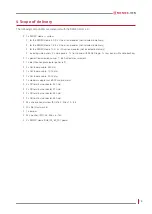
26
Controlling the energy flow
The electronics in the system primarily control the energy flow in the SENEC.Home Li and out of it. The charge
controller primarily regulates the energy flow using values measured at the grid feed-in point.
Transformation of direct current to alternating current
The built-in battery inverter converts the alternating current supplied by the PV inverter into direct current so
that it can be supplied to the battery and stored there in chemical form. Electricity drawn from the storage unit
to supply the household is converted back into alternating current.
6.2.1 SENEC.Inverter battery inverter
The SENEC.Inverter developed in house is used in the SENEC.Home Li. Automatic load sensing ensures
a practically uninterruptible power supply, even if there is no direct sunlight or when switching over. The
SENEC.Inverter is supplied built into the system. Status, consumption and further information can be dis-
played through the monitoring system using a digital communication interface. The SENEC.Inverter converts
the alternating current from the domestic power network into direct current and stores it in the battery block.
When alternating current is required in the household, the SENEC.Inverter converts the direct current back
into alternating current and feeds it into the domestic power network.
6.2.2 Charging electronics
The charging and discharging process is preconfigured in the system and consists of transformer, control
unit (MCU), fuses, grid connection protection and the measuring units. The control system communicates
with the SENEC.Inverter to specify parameters for this. The power flow direction sensor is able to measure
and indicate three-phase currents and voltages in the AC system in both directions in order to measure the
current flows between battery, PV installation and the consumers. Charging and discharging the battery is
also controlled.
6.2.3 Battery
The battery consists of one (SENEC.Home Li 2.5), two (SENEC.Home Li 5.0), three (SENEC.Home Li 7.5) or
four (SENEC.Home Li 10.0) battery modules with a rated voltage of 46.8 V and a net capacity of 56.7 Ah at
a constant discharge of 10 amperes per module. The battery management system built into each battery
module continuously monitors the safety parameters for the module (temperature, current and voltage) to
ensure smooth operation. It is able to shut down battery charging or discharging in exceptional situations,
independently of the software control.
















































